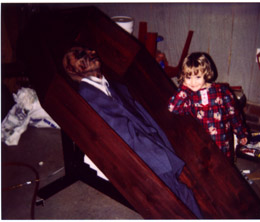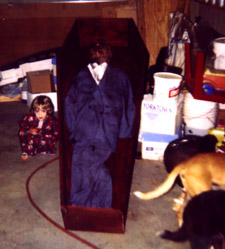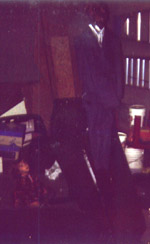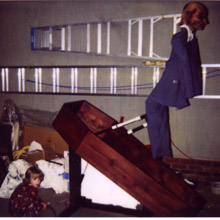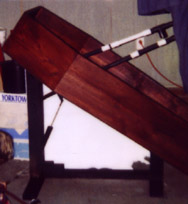 |
||||||
|
|
|
|||||
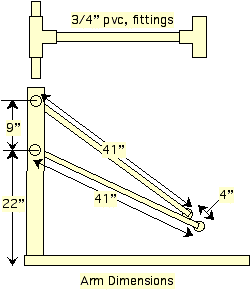 |
(thanks to Beam2000 for the gentle prod to fix the dimensions in this image!)
The arm mechanism uses the four-bar design that is used in lots of
animated props. The basic mechanism
can be used to move props in many ways. The arms are 3/4" pvc.
The supports are 1/x4 verticals with 2x4 horizontal supports. The holes
in the 1x4s are 1" diameter.
2/4 wood blocks were placed between the 1x4s to help brace the 1/4"
verticals.
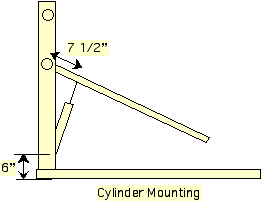 |
Originally I used a heavy duty door closer as an air cylinder. The measurements shown are for this cylinder. If you use another cylinder (and I do recommend using a "real" air cylinder), the measurements will change. Don't be afraid to experiment!
Note:
A 1" bore, 7"-8" throw double acting air cylinder is recommended.
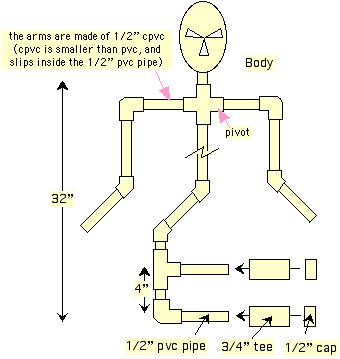 |
Here's some basic info on the body frame I used. The torso portion is
about 32" high, not counting the neck and head. The 4" pivot
measurement is center-to-center. The 3/4" tees slide over the 1/2"
pvc to make the front pivots. 1/2" caps are screwed to the 1/2"
pipe to hold the body frame on the slinging arms. You can glue it... but...
you won't be able to take it apart again! Drill a small pilot hole through
the cap and pipe first. I used 1" drywall screws to hold the caps
on.
The arms are made of 1/2" cpvc that has a smaller diameter than pvc
and can slide easily into 1/2" pvc fittings.
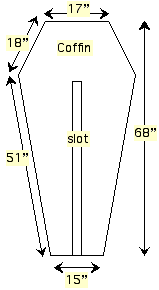 |
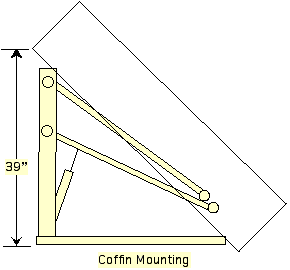 |
The coffin was screwed to the lever arm mount using drywall screws, arranged to pass the arms through.
Here are some responses I've sent to nice people who have asked questions about the body slinger.
The levers:
I first built up a smaller version to test the idea, and get a 'feel' for differences in the arm lengths and spacing. I would highly recommend you try out a smaller version yourself! The concepts for the lever arms are used in lots of motion props. The pieces and dimensions are shown below.
The supports are just 1"x4" uprights screwed into 2"x4"s.
I got several assorted 3/4" PVC fittings and pipe, then started hacking
until it worked. Honestly, I still haven't measured anything. (I got lots
of experience with "I cut it twice and its still too short",
though ;-) ). PVC is really easy to work with, and cheap enough to waste
a bit. I didn't glue the pipe and fittings until I got the assembly the
way I wanted it - that help the trial and error a bit. I would recommend
not using the air cylinder to 'sling' the body until the pipes are cut
to size - like a dummy I did, and it REALLY threw parts everywhere! My
wife got used to hear me yelling "fire in the hole!" as a warning
to get the kids and dogs out of the way. (luckily PVC pipe bounces off
of cars and freezers... sigh...)
Oh yeah, one "minor" detail thats critical... I needed to stiffen
the bottom lifter arm (the one connected to the air cylinder) for the
slinger to actually pitch the body forward when its near the top of the
stroke. Otherwise, the body never swings forward. I used a piece of 1/2"
stiff copper pipe stuffed inside the PVC pipe, then used sheet rock screws
to attach the top part of the air cylinder connector to the pipe - just
drilled through both pipes. I was surprised how sturdy it is.
The air cylinder:
I used a 'heavy duty' door closer for an air cylinder because it was
a bit larger in diameter than the standard door closer. I used a 1/8"
- 1/4" adapter to connect the cylinder to the air line. I got it
at Home Depot (part A-22 in a plastic bag in the pipe parts area). One
side is threaded, the other is for a pressure fit air line. I force fit
the threaded end into the screw hole, then liberally applied epoxy around
it to seal and hold the joint. This assembly has worked very well for
pressures I've tested over 80psi (I dont recommend using a door closer
at those pressures, though!).
The load on the cylinder still means I need to force 60-70psi into it
to get good movement. Yes, overcoming the internal return spring is part
of the problem. I never bothered to remove it because I like the 'forced'
return, and I didnt want to weaken it around the business end attempting
a spring removal. I'll change it out for a 'real' air cylinder eventually,
but it has worked great so far for over 50 firings. In retrospect, I would
recommend using a 'real' air cylinder for two main reasons: 1) They can
be found cheaply in surplus catalogs such as C & H and Surplus Sales
2) They are much stronger and safer and built to handle higher pressures.
If you are seriously considering building the 'slinger', get a 'real'
air cylinder with at least 1" bore and 4"-5" of throw.
Triggering
Once in the haunt to trigger the unit, I'm going to try a floormat and a motion detector (whichever works best) connected to an event timer that triggers an air solenoid. Because the air line at the cylinder is only 1/8", Im using a surplus 1/8" two way air solenoid. The door closer leaks enough to vent the air out on the return stroke.
NOTE:
Before using any information here,
please read our Disclaimer.
![]()
Copyright
© 1995-2008 Myth Adventures, Inc.
All Rights Reserved
